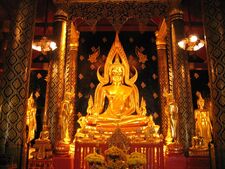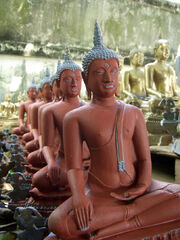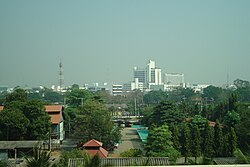| Main | Births etc |
|---|
| Phitsanulok พิษณุโลก |
|
|---|---|
| — City Municipality — | |
| The Phitsanulok skyline from the Grand Riverside Hotel | |
| Nickname(s): Song Khwae (The two rivers) | |
| Coordinates: Coordinates: | |
| Country | Thailand |
| Province | Phitsanulok |
| Amphoe | Mueang Phitsanulok |
| Government | |
| • Type | City municipality |
| • Mayor | Premrudee Champunot |
| Area | |
| • Total | 10.815 km2 (4.176 sq mi) |
| Population | |
| • Total | 84,311 |
| • Density | 7,795.7/km2 (20,191/sq mi) |
| Time zone | Thailand (UTC+7) |
| Postal code | 65000 |
| Geocode | 650101 |
| Chief roadway | Route 12 |
| Chief watercourse | Nan River |
| Chief airport | Phitsanulok Airport |
| Website | [1] |
Phitsanulok (Thai: พิษณุโลก, pronounced [pʰít.sa.nú.lôːk]) is an important and historic city in lower northern Thailand and is the capital of Phitsanulok Province, which stretches all the way to the Laotian border. Phitsanulok is one of the oldest cities in Thailand, founded over 600 years ago. It is probably best known as the birthplace of King Naresuan, who freed the country from Burmese domination in the late 16th century, and his brother and successor King Ekathosarot (Sanphet III). As the cross-road between the northern and central regions of the country, it has long been important both for political and strategic reasons, and was fought over many times in centuries past. Phitsanulok was the capital of Thailand for 25 years during the reign of King Boromma Trailokanat of Ayutthaya. Located on the banks of the Nan River, the city was originally a small Khmer outpost known as Song Kwae, before the Khwae Noi River changed its course in the 11th century AD. Phitsanulok was also a provincial center of the Angkorian Empire during the Angkorian period.[1] Phitsanulok is home to Naresuan University and Pibulsongkram Rajabhat University, as well as to a major Royal Thai Army base.
Etymology[]
- Song Khwae-The first element, 'song', means the number two. The second element, 'khwae', means tributary. A loose translation of the entire name would be Two Rivers.
- Phitsanulok-The first element, 'Phitsanu' (Thai: พิษณุ), is a cognate of Vishnu, a Hindu god (see, e.g. Witnu, Thai: วิษณุ). Lack of a v sound in the Thai language accounts for the two forms. The second element, 'lok' (Thai: โลก,) means globe or world. A loose translation of the entire name would be Vishnu's Heaven.
Geography[]
Phitsanulok is located approximately 377 km north of Bangkok.[2]
Climate[]
Phitsanulok has a tropical savanna climate (Köppen climate classification Aw). Winters are dry and very warm. Temperatures rise until April, which is very hot with the average daily maximum at 37.4 °C (99.3 °F). The monsoon season runs from May through October, with heavy rain and somewhat cooler temperatures during the day, although nights remain warm.
| Climate data for Phitsanulok | |||||||||||||
|---|---|---|---|---|---|---|---|---|---|---|---|---|---|
| Month | Jan | Feb | Mar | Apr | May | Jun | Jul | Aug | Sep | Oct | Nov | Dec | Year |
| Record high °C (°F) | 36.3 (97.3) |
38.0 (100.4) |
40.3 (104.5) |
41.8 (107.2) |
42.0 (107.6) |
38.7 (101.7) |
38.4 (101.1) |
36.7 (98.1) |
36.6 (97.9) |
35.3 (95.5) |
35.7 (96.3) |
35.6 (96.1) |
42 (107.6) |
| Average high °C (°F) | 31.6 (88.9) |
33.9 (93.0) |
35.9 (96.6) |
37.4 (99.3) |
35.6 (96.1) |
33.6 (92.5) |
32.8 (91.0) |
32.3 (90.1) |
32.3 (90.1) |
32.3 (90.1) |
31.7 (89.1) |
30.9 (87.6) |
33.36 (92.04) |
| Daily mean °C (°F) | 24.1 (75.4) |
26.7 (80.1) |
29.0 (84.2) |
30.6 (87.1) |
29.6 (85.3) |
28.5 (83.3) |
28.1 (82.6) |
27.8 (82.0) |
27.8 (82.0) |
27.6 (81.7) |
26.1 (79.0) |
24.0 (75.2) |
27.49 (81.49) |
| Average low °C (°F) | 18.0 (64.4) |
20.8 (69.4) |
23.5 (74.3) |
25.3 (77.5) |
25.2 (77.4) |
24.8 (76.6) |
24.6 (76.3) |
24.5 (76.1) |
24.5 (76.1) |
24.0 (75.2) |
21.6 (70.9) |
18.3 (64.9) |
22.93 (73.27) |
| Record low °C (°F) | 8.9 (48.0) |
13.2 (55.8) |
12.7 (54.9) |
19.1 (66.4) |
20.4 (68.7) |
21.8 (71.2) |
21.6 (70.9) |
22.2 (72.0) |
21.5 (70.7) |
17.6 (63.7) |
12.1 (53.8) |
9.4 (48.9) |
8.9 (48.0) |
| Precipitation mm (inches) | 7 (0.28) |
12 (0.47) |
29 (1.14) |
51 (2.01) |
188 (7.4) |
183 (7.2) |
190 (7.48) |
257 (10.12) |
241 (9.49) |
157 (6.18) |
31 (1.22) |
6 (0.24) |
1,352 (53.23) |
| Avg. precipitation days (≥ 1.0 mm) | 1 | 1 | 2 | 4 | 12 | 13 | 14 | 17 | 15 | 9 | 3 | 1 | 92 |
| Source: NOAA (1961-1990)[3] | |||||||||||||
Topography[]
Phitsanulok is primarily flat lands with some hills.[2] The eastern portion of the city has some wooded area.[2] The city is situated in the Nan Basin, which is part of the Chao Phraya Watershed.[4] Phitsanulok is sometimes called Song Kwae, the city of two rivers, an ancient name dating to a time centuries ago when the Nan and Khwae Noi Rivers met near the city. Today, only the Nan River flows through Phitsanulok.
History[]
| Template:History of Phitsanulok Province |
Khmer Empire[]
During the 11th century, the city of Phitsanulok was but a small Khmer outpost called Song Khwae, meaning two rivers.[2] At that time, the Nan and Khwae Noi Rivers both flowed through the city, making it a strategic gateway to northern Thailand. The Thais were the majority in the area, however, and would soon establish their independence and form the Kingdom of Sukhothai.
Sukhothai Period[]
- Phitsanulok was the major city in the east of the Sukhothai Kingdom.
- Construction of Wat Aranyik and Wat Chedi Yod Thong
Ayutthaya Period[]
- Wat Phra Sri Rattana Mahathat was constructed in 1357.
- King Borommatrailokanat moved the capital of the Ayutthaya kingdom to Phitsanulok in 1463 to strengthen the northern boundary of the kingdom.
- Construction of Wat Ratchaburana and Wat Nang Phaya during reign of King Borommatrailokanat
- King Borommatrailokanat's successor Boromma Ratchathirat III returned the capital of the Ayutthaya kingdom to Ayutthaya.
- In 1555, King Naresuan the Great was born in the city.[5]
- Phitsanulok was a major place of recruitment during Ayutthaya's wars with Burma.[5]
- Mother-of-pearl inlaid doors were made in 1756 for the entrance to Wat Phra Sri Rattana Mahathat by order of King Boromakot.
- After the fall of Ayutthaya to the Burmese in 1767 and the death of its last ruler, a mad monk proclaimed himself king and seized control of Phitsanulok from its royal governor. King Taksin the Great was himself wounded by a musket ball during an unsuccessful attempt to capture the city from the monk.
19th Century[]
King Mongkut ordered the restoration of Wat Ratchaburana.
20th Century[]
- The Phitsanulok fire of 1955 destroyed much of the older portion of the city of Phitsanulok.
- On Nov 28, 1961, the King Naresuan Shrine was completed at Chandra Palace.
- On January 25, 1967, the Phitsanulok campus of what is now Naresuan University was established as the northern branch of the College of Education.
- Naresuan Dam was constructed throughout the span of 1976 to 1985 on the Nan River as part of the Phitsanulok Irrigation Project.[6] The dam was designed to help prevent flooding of the city.
Recent Events[]
- In June, 2001, Phitsanulok hosted the Asia-Pacific Summit of Women Mayors and Councillors.[7]
Government[]
The chief executive of the city is the mayor. During election campaigns, candidates use signs, vehicles with loud speakers, and political parades to obtain voters.
Royal Thai Army[]
Phitsanulok is home to the Third Army Region of the Royal Thai Army, responsible for the northern and northwestern parts of the kingdom..
Channels of Public Communication[]
The main channels for communication in the city are television and radio, although internet use is emerging in Phitsanulok. The following public television and radio stations[8] are broadcast from Phitsanulok:
- Sathaanii Witthayu Krajaisiang Thahaan Aakaat (Air Force Radio Station), 954 AM and 95.75, in the City of Phitsanulok
- Witthayu Kong Phon Thahaan Raap Thii Sii (4th Infantry Division), 1377 AM, at Fort Somdet Phra Naresuan Maharat
- Sathaanii Witthayu Phitaksantiraat (Communications Division, Royal Thai Police), 1422 AM, in Phitsanulok City
- ARMY-5 (television channel 5, owned and operated by the Royal Thai Army)[9]
- PRD-11 (television channel 11, owned and operated by the Government Public Relations Department)[9]
Demographics[]
Ethnic Diversity[]
The majority ethnicity in the city is Thai. Others in the city consider themselves of Mon descent.
Language[]
The vast majority of residents of Phitsanulok speak Central Thai. Some residents speak English as well.
Religion[]
The people of Phitsanulok are predominantly Theravada Buddhists (as are 95% of the Thai population as a whole), although some minority religions are practiced.
Infrastructure[]
Educational Institutions[]
Naresuan University (abbreviated as Mor Nor for Mahawithayalai Naresuan) is an educational center of the Lower Northern region of Thailand. Located in Tambon Tha Pho, near the city of Phitsanulok, the university is named after King Naresuan the Great, and the campus contains a large statue of him. Other universities and colleges in or around the city include Phitsanulok College (a private college), Sirindhorn College of Public Health, Rajabhat Pibulsongkram University and the Phitsanulok campus of the Rajamangala University of Technology Lanna. There are numerous kindergartens, elementary schools, high schools and vocational schools in the province. CPS Institution, a private language school, is located at the Tesco lotus Extra and offers courses in English, Japanese and Thai.
Hospitals[]
There are several hospitals in the city, both public and private. The province's and the city's primary public hospital is Buddhachinaraj Phitsanulok Hospital and the regional super tertiary care hospital is Naresuan University Hospital which located inside Naresuan University, Tambon Tha Pho, 10 kilometers south of the city center.
Temples[]
The city is home to the following 12 active temples where Theravada Buddhism is practiced by city residents:
- Wat Phra Sri Rattana Mahathat (Thai: วัดพระศรีรัตนมหาธาตุ)
- Wat Ratchaburana (Thai: วัดราชบูรณะ)
- Wat Aranyik (Thai: วัดอรัญญิก)
- Wat Nang Phaya (Thai: วัดนางพญา)
- Wat Chedi Yod Thong
- Wat Tamajak (Thai: วัดธรรมจักร)
- Wat Mai Opayaram (Thai: วัดใหม่อภัยาราม)
- Wat Kuha Sawan (Thai: วัดคูหาสวรรค์)
- Wat Nong Bua (Thai: วัดหนองบัว)
- Wat Sri Wisut Tharam (Thai: วัดศรีวิสุทธาราม)
- Wat Sra Gaew Pratum Thong (Thai: วัดสระแก้วปทุมทอง)
- Wat Tha Maprang (Thai: วัดท่ามะปราง)
Transportation[]
Phitsanulok is a good starting point for a visit to the World Heritage site at nearby Sukhothai. The city can be reached by both rail and air (Phitsanulok Airport), and is on the intersection of several major highways linked between Northern, Northeastern and Central region of Thailand: Highway No.11 (Ta Khli - Chiang Mai), Highway No. 12 (Mae Sot - Mukdahan) and Highway No. 117 (Phitsanulok - Nakhon Sawan).
Culture[]
| Template:TheravadaBuddhism |
Much of the culture in the city centers around the Theravada Buddhist traditions of its residents.
Theravada Buddhism[]
Most residents are active followers of the Theravada Buddhist religion. Buddhism is practiced at the many temples or wat located throughout the city.
Art[]
Phitsanulok is home to a number of historic sculptures of the Buddha and other religious artwork including the Buddha Chinnarat, the Buddha Chinnasri, the Phra Sri Satsada.
Literature[]
Examples of important literary works of Phitsanulok include:
- Lilit Yuan Pai (Thai: ลิลิตยวนพ่าย, English: "Tale of the Fall of Lanna")
- Lilit Prá Lô (Thai: ลิลิตพระลอ, English: "Tale of the Hero Lô")
- Klohng Táwâatsàmàat (Thai: โคลงทวาทศมาส, English: "Poem of the Twelve Months")
- Gam Sŏn Sĕe Bpràat (Thai: กำศรวลศรีปราชญ์, English: "The Legendary Wise Archer's Grip")
The predominant literary language (as well as the predominant spoken language) is the Central Thai dialect of the Thai language, which is written in the Thai alphabet.
Sports[]
Dragon boat racing has historically been an important element of Phitsanulok's culture. In recent times, football (soccer) has become increasingly popular. In 2005, Phitsanulok won the 2nd Northern Youth Football Championship in the U12 and U15 age groups.[10] Traditional Thai boxing is also a major sport in the city.
Western Influence[]
Recently, western culture has influenced the regional culture, introducing western style dress (although traditional dress is still worn at certain ceremonies and festivals), and western sports such as soccer. As methods of communication with the western world continue to improve, especially with growing community access to internet technology and mobile phones, the trend is likely to continue.
Temples[]

Phra Buddha Chinnarat
Wat Phra Sri Rattana Mahathat[]
Phitsanulok's main tourist attraction is Wat Phra Sri Rattana Mahathat, known locally simply as Wat Yai (the big temple). This famous temple, built in 1357, is home to the Phra Buddha Chinnarat, which is one of the most revered Buddha figures in Thailand, and the official symbol of the entire Phitsanulok Province. (An exact replica exists in the Marble Temple in Bangkok, and another in Wat Saranat Thammaram in Rayong.) The beautiful mother-of-pearl inlaid doors were built in 1756 by order of King Boromakot of Ayutthaya. The Buddha Chinnarat National Museum, located on the temple grounds, houses a sizeable collection of Sukhothai period art. A large provincial fair is held at the temple every January.
Other Historic Temples[]
- Wat Ratchaburana
- Wat Aranyik is a Sukhothai era temple, surrounded by moats.
- Wat Nang Phaya
- Wat Chedi Yod Thong
Wat Chula Manee is also located several kilometers outside the city in Tha Thong.
Other Attractions[]
Sergeant-Major Dr. Thawee Buranakhet Folklore Museum[]
The Sergeant-Major Dr. Thawee Buranakhet Folklore Museum hosts a collection of folk arts, crafts, basketry, pottery and ancient kitchen utensils.[11] The museum also houses a collection of antiaue traps for catching snakes, birds, tigers and porcupines.
City Walls[]
Unfortunately, most of the older portions of Phitsanulok were destroyed in a disastrous fire which occurred in 1955. Thus little else remains of the old town besides the famous temple, an ancient chedi across the road from it and a small section of the city wall. The intact portions of the ancient city wall is accessible to visitors.[11]
Buranathai Buddha Foundry[]

Buranathai Buddha Foundry
The Buranathai Buddha Foundry specializes in casting bronze Buddha images.[12] It is the only establishment of this kind in the province.[12] Craftspersons specialize in the reproduction of the Phra Buddha Chinnarat Buddha image.[12] Visitors are permitted to walk along the production line.[12]
Nan River Houseboats[]
Phitsanulok is known throughout Thailand for the houseboats which still line the Nan River near Wat Phra Sri Rattana Maharat, though regretably in recent years these are becoming fewer.[11] A houseboat museum is also open for visitors.
Night Market[]
Each night, vendors in Phitsanulok gather to form Phitsanulok's night market. Items sold include clothing and food.
Chandra Palace[]
The Chandra Palace was the birthplace of King Naresuan the Great, and contains a King Naresuan the Great Shrine.
Naresuan University Art and Culture Gallery[]
The Naresuan University Art and Culture Gallery holds over 100 artistic artworks of culturally significant Thai artists.
Festivals and Annual Events[]

River houses in Phitsanulok
Phra Buddha Chinnarat Fair[]
The Phra Buddha Chinnarat Fair is held each January at Wat Phra Sri Rattana Mahatat Woramahawihan.
Suan Chom Nan Park Festival[]
The Suan Chom Nan Park festival is held twice a year along the Nan River. Food and local products are sold to attendees.
Dragon Boat Races[]
On the first weekend of each October, the Dragon Boat Races are held outside Wat Phra Sri Rattana Mahatat Woramahawihan in the Nan River. Each dragon boat has a crew of approximately 30 oarsmen.
Issues of Public Concern[]
Primary issues of public concern within the province are poverty, health care, pollution, education, [13] prostitution and ,[14] HIV,[13] Measures have been taken to address many of these concerns including heightened enforcement of crimes involving women trafficking and implementation of a Solid Waste Management Program for Phitsanulok[15]
Poverty[]
It is estimated that around 10% of the population in the city of live below the poverty line. [16]
Health Care[]
[17] Critics of Thaksin's health care program, however, suggest that prior to the coup, the program was diminishing the quality of health care in rural provinces such as Phitsanulok by bankrupting hospitals and causing doctors to resign from the public sector and relocate to Bangkok.[18]
References[]
- ^ Thailand, A Short Story, David K. Wyatt, ISBN 0-300-03054-1
- ^ a b c d ThaiTambon.com
- ^ "Climate Normals for Phitasnulok". National Oceanic and Atmospheric Administration. ftp://dossier.ogp.noaa.gov/GCOS/WMO-Normals/RA-II/TH/48378.TXT. Retrieved 3 February 2013.
- ^ Basins in Thailand
- ^ a b Province page from the Tourist Authority of Thailand
- ^ Phitsanulok Irrigation Project
- ^ Asia-Pacific Summit of Women Mayors and Councillors
- ^ Radio Stations in Phitsanulok Province, Thailand
- ^ a b Thai TV: Television Stations in Thailand on VHF and UHF
- ^ Phitsanulok wins the 2nd Northern Youth Football Championship
- ^ a b c Thailand Guidebook-Phitsanulok Province
- ^ a b c d Buranathai Buddha Casting Foundry
- ^ a b Phitsanulok on unescap.org
- ^ Article on Women Trafficking on ibiblio.org
- ^ Solid Waste Management Program for Phitsanulok
- ^ Health System Reform and Ethics
- ^ Medical Tourism in Thailand
- ^ Thailand's Health Care Plan Creates Challenges for Hospitals
Template:Metropolitan cities of Thailand
| This page uses content from the English language Wikipedia. The original content was at Phitsanulok. The list of authors can be seen in the page history. As with this Familypedia wiki, the content of Wikipedia is available under the Creative Commons License. |


